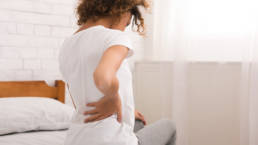Neck and Shoulder Pains in Children
Working adults often experience the all too familiar neck and shoulder pain which comes after a period of high stress and long hours of work. We often attribute this to sitting too long as well as poor lifestyle and ergonomic factors that may place stress on our joints, muscles, nerves and mental well being. Believe it or not children are beginning to develop neck and shoulder pain which can impair their performance at school, sport, and extra curricular activities.
Neck and shoulder pains can also negatively affect a child’s mood and overall sense of well being. In this modern day and age, the schooling adolescent population may undergo just as much stress and demands as the average adult.
With children and teenagers spending more time being:
- sedentary (reading, computer work, ipad usage, television, video games, mobile phone use, studying, playing musical instruments)
- physical stress (high level sporting, working in sustained positions, heavy school bags, poor work postures)
- being under pressure (examinations, peer pressure, sporting competitions, examinations).
It’s no wonder that many of them experience neck and shoulder pains!
Studies have shown that adolescents are spending less and less time being active and succumbing to poor lifestyle habits and choices. This severely impacts on both musculoskeletal health, life expectancy, quality of life and mental health.
Believe it or not spending too much time sedentary has been linked strongly to living shorter!
- So far neck and shoulder pain is a common phenomenon with 50% of girls & 33% of boys experiencing it,
- High level sporting and active girls are more prone to develop neck and shoulder pains than boys,
- At the same time boys tend to develop neck and shoulder pain with computer related activities more than girls and
- When it comes to prolonged sitting both boys and girls are affected negatively in their neck and shoulders.
As a Physiotherapist I recommend parents:
1.Talk to your child
There is no such thing as the ‘normal’ pain with daily activities, pain is often a warning sign and should not be ignored and left unchecked. Sometimes the young may fail to mention about their pains or commonly be unheard and dismissed by others. They may even fail to mention it simply because it may be perceived as minor.
Identifying the source, cause and drivers of pain early is essential with any musculoskeletal condition and keeping it well in check when minor is always advised, as opposed to allowing exacerbation.
2.Be informed on your child’s posture
Poor postures can result in necessary loading of joints, muscles, nerves which can lead to damage and injuries. With the young, these can often be rectified with ease as to prevent carrying such habits into adulthood.
Unfortunately the simple stand straight/sit up straight cue given to children may not be applicable in some cases. Constantly reminding a child to be overly ‘straight’ in the back could exacerbate a condition and may often carry over to ‘fear-avoidance of certain movements’, overly ‘catastrophizing and focusing on pain signals’ when carried over to adulthood may pose a significant problem.
Consult your Physiotherapist or healthcare professional and be more empowered with knowledge on posture.
3. Check the weight of their school bag
It is common knowledge that heavy school backs may be the cause of neck, shoulder and back pain in adolescents, about more than 40% of incidence occurrence is reported. It is proven that the use of a backpack can alter the way the human body holds itself and affect some muscles in the body. Strangely enough some studies point out that in the average schooling population bag weight does not correlate clearly to reported pain when the backpack is used correctly. Instead pain is more linked with the method of carrying the school bag and weight distribution of straps. What is also noted is that there is a strong psychosomatic link between the backpack and pain experienced.
Parents should ensure that their child is equipped with an adequate backpack that is designed to spread load evenly across the shoulders (via good straps) and that the backpack is optimized for appropriate spinal loading. Each and every child and backpack is unique. Contact your Healthcare Professional or Physiotherapist for further advice if unsure.
There is no denying that an extremely heavy bag will likely result in injuries, but sometimes there are other factors involved when a young individual experiences pain.
If you are in need of assistance with neck and shoulder pain feel free to contact our friendly staff at (08) 9321 1964
References
AUVINEN J, TAMMELIN T, TAIMELA S, ZITTING P, & KARPPINEN J. (2007). Neck and shoulder pains in relation to physical activity and sedentary activities in adolescence. Spine. 32, 1038-44.
VAN GENT C, DOLS JJ, DE ROVER CM, HIRA SING RA, & DE VET HC. (2003). The weight of schoolbags and the occurrence of neck, shoulder, and back pain in young adolescents. Spine. 28, 916-21.
RENEMAN, M. F., POELS, B. J. J., GEERTZEN, J. H. B., & DIJKSTRA, P. U. (2006). Back pain and backpacks in children: Biomedical or biopsychosocial model? Disability & Rehabilitation. 28, 1293-1297.
Related Posts
How to Treat Sciatica Pain
2 September 2016
Sciatica is a common issue in many individuals, from sporting and active individuals to even the elderly. As the term is becoming more popular in the allied health and sporting community in Perth, it is important for patients to understand what sciatica really is.
0 Comments2 Minutes
Explaining the Enteric Nervous System
2 May 2017
This article focuses on the role of the enteric nervous system (ENS) for overall health. The ENS is a system of cerebral nervous tissue which is in structure and function very similar to the brain. This is why the ENS is called the ‘The second brain’.
0 Comments5 Minutes


